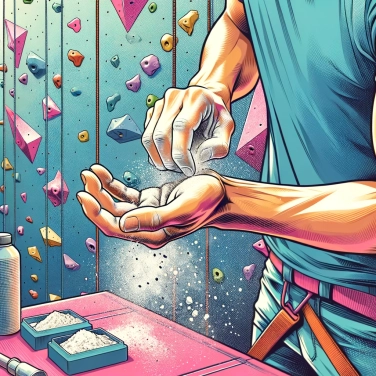Climbers chalk their hands before climbing to absorb moisture and sweat, thus improving their grip and reducing the risk of slipping during the climb.

When hands sweat, they become more slippery, compromising the essential grip in climbing. Magnesium acts simply like a sponge: it absorbs moisture, dries quickly, and prevents hands from slipping on holds. As a result, the grip becomes more secure, climbers ascend with more confidence, and minimize the risks of falls or technical errors due to sweaty hands. Magnesium also reduces the constant need to wipe hands during exertion, allowing climbers to stay focused longer on their climb.
Magnesium quickly absorbs sweat and gives the skin a dry and rough texture. This feeling facilitates better grip by creating more friction between the hands and the hold or rock. By limiting the risk of slipping, climbing becomes more precise, safer, and helps conserve your energy during a difficult or lengthy route. Less unnecessary effort also means less accumulated fatigue, which directly improves your performance. Furthermore, the confidence provided by good grip plays a significant role in the effectiveness and fluidity of the climber's movements.
Magnesium used in climbing mainly exists in three forms: powder, blocks, or liquid. The most common is powder, which is convenient as it quickly and easily covers the hands. It is stored in small bags called chalk bags, attached to the waist or placed nearby. To use it, the climber simply dips their hands into it, rubs a bit, and off they go. Solid blocks of magnesium can be broken or crushed to obtain powder directly, or they can be used as they are by rubbing them directly in the hands according to personal preference. Liquid magnesium, a mixture of powder and alcohol, dries quickly after application, adheres well to the skin, and is particularly suitable for indoor use, as it limits clouds of dust. With it, there's no need to reapply too often because it lasts longer. Whatever type is chosen, the goal remains the same: to keep the hands dry for optimal grip.
In climbing, magnesium generally enhances safety, as it clearly reduces the risk of slipping due to wet or clammy hands. Fewer slips also mean fewer unexpected falls and therefore fewer potential injuries. But be careful, excessive use of magnesium leaves residues on the holds. In the long run, this creates a slippery layer that is dangerous for the next climber. That’s why it is essential to regularly brush the holds after use, out of respect and especially for safety! Many climbing sites even explicitly ask climbers to clean up after themselves to limit these risks.
Some climbers try, for example, rosin, which is mainly found among gymnasts or in circuses: it sticks well, but perhaps too much. It leaves a difficult-to-clean residue on holds. Not practical.
Other options, like climbing gloves, directly limit skin-to-rock contact and reduce tactile sensations. As a result, you lose the same feeling, and the precision of your movements can suffer.
Then there are liquid anti-slip solutions, convenient because they leave fewer traces, but they are less effective in the long run: climbers need to reapply them more often. And that can get expensive quickly.
Finally, some use sand or dry dirt as an emergency fix in nature: it's clearly less effective, doesn't grip well, absorbs little, and in terms of sensation, it's lacking.
The excessive use of magnesium on outdoor climbing routes can create what climbers call 'white marks' that are visible from a great distance; this is why some climbing sites prohibit or limit its use.
There is "liquid magnesium," a cleaner alternative in the form of a lotion made from alcohol and magnesium carbonate. This product, once applied, dries quickly, leaving a thin, adherent white layer on the hands!
Magnesium carbonate was initially used by gymnasts before becoming a staple in climbing. Today, it is ubiquitous in sports that require a strong grip, such as weightlifting or CrossFit.
Some international climbing competitions strongly encourage the use of colored chalk, which blends better with the natural color of the rocks, thereby limiting the visual and aesthetic impact on the environment.
Yes, liquid magnesium is a very popular alternative to powdered magnesium. It notably has the advantage of generating less dust, providing a longer-lasting effect on the skin, and ensuring an even distribution on the hands. However, it takes a bit longer to dry.
In the long term, the intensive use of powdered magnesium leaves white residues on climbing surfaces, sometimes making holds slippery or polluting the rocky environment. That is why some climbing gyms or natural sites require cleaning or recommend less polluting alternatives such as liquid magnesium or magnesium balls.
Washing with plain water is often sufficient, but in the case of frequent use, it is advisable to thoroughly moisturize your hands after the session to avoid skin dryness. Some climbers also appreciate gentle or moisturizing soaps to restore the skin after regular use of chalk.
Yes, generally, the magnesium used in climbing (magnesium carbonate) is the same as that used in gymnastics and other sports to enhance grip by reducing hand sweat.
Absolutely, some climbers are able to climb effectively without using chalk. However, this greatly depends on individual physical condition, hand moisture, ambient temperature, and climbing style. Generally, chalk does provide a significant advantage in terms of grip and safety.

No one has answered this quiz yet, be the first!' :-)
Question 1/5